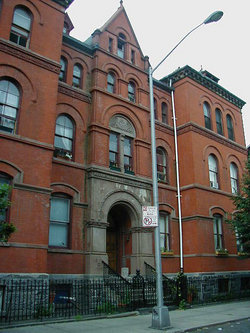St. Mary's Church (Dunell Hills): Difference between revisions
No edit summary |
|||
| Line 22: | Line 22: | ||
You are inside '''St Mary's Church'''. | You are inside '''St Mary's Church'''. | ||
=== Outside === | === Outside === | ||
You are standing outside '''St Mary's Church''', | You are standing outside '''St Mary's Church''', a narrow red-brick building with a fountain at its entrance. | ||
== Barricading Policy == | == Barricading Policy == | ||
The [[DHPD]] [[DHPD/Policies_and_Procedures#Barricading_Policy|Barricading Policy]] provides that this building should not be barricaded, whether the suburb is in normal or Lock-Down condition. | The [[DHPD]] [[DHPD/Policies_and_Procedures#Barricading_Policy|Barricading Policy]] provides that this building should not be barricaded, whether the suburb is in normal or Lock-Down condition. | ||
Revision as of 21:26, 23 October 2009
| St. Mary's Church
Dunell Hills [08,37]
Basic Info:
|
There are three locations named St. Mary's Church in the city of Malton. This article is about the one in Dunell Hills.

St. Mary's Church [8, 37] is located in the southeastern section of Dunell Hills.
Description
Inside
You are inside St Mary's Church.
Outside
You are standing outside St Mary's Church, a narrow red-brick building with a fountain at its entrance.
Barricading Policy
The DHPD Barricading Policy provides that this building should not be barricaded, whether the suburb is in normal or Lock-Down condition.
Tactical Resource Points
The nearest of each type of tactical resource point to St. Mary's Church:
- Nearest Hospital is 2 blocks away - Zephyrinus General Hospital at [6, 36].
- Nearest Mall is 11 blocks away - Caiger Mall at [19, 28].
- Nearest NecroTech Building is 3 blocks away - The Dury Building at [5, 36].
- Nearest Police Department is 2 blocks away - Broadbelt Grove Police Department at [7, 35].
History and Significance
St. Mary
While there are no fewer than eighteen saints bearing the name Mary, most churches called St. Mary's without some more specific identifier (i.e., St. Mary of Cleophus) are named for the Blessed Virgin, Mother of God.
Mary's role in the coming of a Messiah was foretold in several places in the Old Testament, particularly Isaiah 7:14 ("Behold a virgin shall conceive, and bear a son"). She was born in Jerusalem in approximately 20 BCE to parents identified in the apocryphal Gospel of James as St. Joachim and St. Anna, whose prayers for a child in their advanced age were answered. Contrary to common belief, the term Immaculate Conception actually refers to Mary herself and not to her son Christ; in 1854, Pope Pius IX decreed that Mary "in the first instance of her conception, by a singular privilege and grace granted by God, in view of the merits of Jesus Christ, the Saviour of the human race, was preserved exempt from all stain of original sin."
The archangel Gabriel came to Mary in Nazareth and told her that she was to give birth to the Messiah (Luke 1:26-38). According to Matthew (1:18-21), another angel visited Mary's betrothed, Joseph of Nazareth, to prevent Mary's condition from destroying the betrothal. As she neared her term, the Emperor Augustus ordered a census of the entire Roman Empire, so Mary and Joseph had to travel to Bethlehem for Joseph's registration; there Christ was born, in about 5 BCE. The baby was taken to Jerusalem to be presented at the Temple in accordance with Jewish law; there the holy man Simeon recognized him as the Messiah (Luke 2:22-35). Soon afterward, yet another angel came to Joseph and told him that they must flee the wrath of Herod, the Roman-backed puppet king of Judea. The family hid in Egypt until Herod's death, then returned to Nazareth.
Mary played a pivotal role in some of the major events of Christ's life. In Luke 2:42-50, Mary found the twelve-year-old Christ sitting with the learned men of Jerusalem, asking them questions and astonishing them with his wisdom. In John 2:1-11, she spurred Christ to perform his first miracle, turning water to wine at a wedding in Cana. She stood at the foot of the Cross with Mary Magdalene (John 19:25-27). She was with the disciples after the Passion through the Pentecost (Acts 1:14-2:4). For the most part, however, the Gospels are silent as to her life during and after the ministry of Christ.
The belief that Mary was assumed bodily into Heaven at the moment of her death is one of the oldest traditions of the Catholic Church and was declared dogmatic by Pius XII in 1950.
